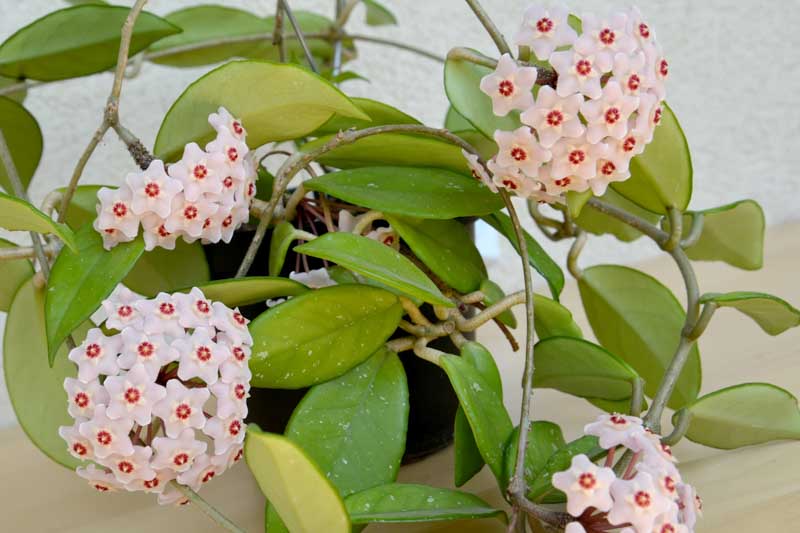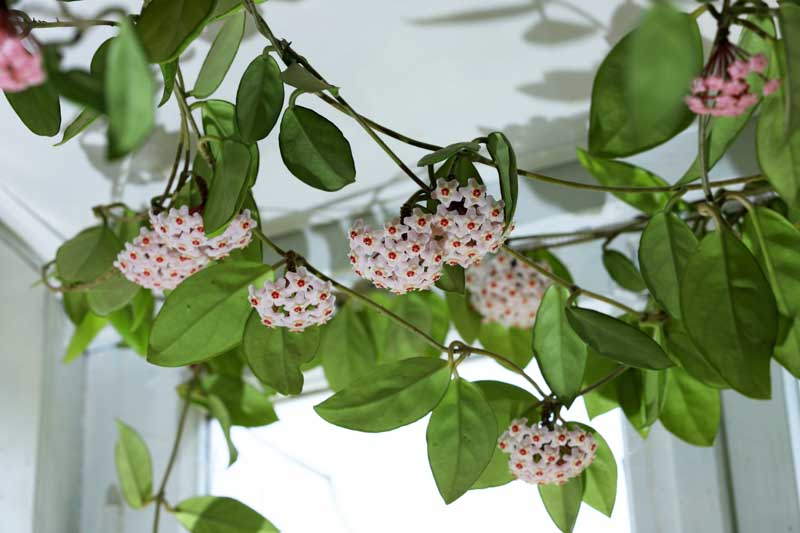Honey Plant, Porcelainflower, Porcelain Flower, Wax Plant
Hoya carnosa, commonly known as the wax plant, is a perennial evergreen that’s as intriguing as it is decorative. This climbing vine has gained popularity for its lush, waxy foliage and stunning, fragrant flowers, making it a favorite among houseplant enthusiasts.
Hoya carnosa boasts thick, leathery leaves that grow along its vine-like stems, creating a lush, cascading effect. The leaves are typically dark green, but variegated varieties offer splashes of white, yellow, or pink.
Native: Originally from East Asia and Australia, Hoya carnosa thrives in tropical and subtropical environments, clinging to trees and rocks in its natural habitat. It belongs to the dogbane family (Apocynaceae), along with plumeria, periwinkle, mandevilla, or oleander.
Plant Type and Habit: Hoya carnosa is a vigorous evergreen climber that can grow upwards with support or trail gracefully from hanging baskets. It’s adaptable, thriving as an indoor potted plant or outdoor perennial in warm climates.
Size: Indoors, Hoya carnosa can reach lengths of 3-6 feet (90-180 cm) or more, with proper support and care. Outdoors, it can grow even longer, up to 12-20 feet (3.6 to 6 meters), depending on its climbing structure.
Hoya Flower: The plant is renowned for its beautiful star-shaped flowers that bloom in clusters. These waxy, porcelain-like flowers are red-centred, pink, or white and emit a sweet fragrance, especially in the evening. Hoya carnosa typically blooms from spring to fall, with proper care and mature plants (2 or 3 years old) more likely to flower. Flowering can be sporadic, and it may take several years for a new plant to bloom.
Fruit: The fruit of Hoya carnosa is rarely seen in cultivation. It produces seed pods that split open to release seeds with tufts of hair, allowing wind dispersion.
Foliage: Hoya carnosa, known for its thick, waxy, and lush green leaves, showcases an evergreen foliage that exudes a glossy sheen. The leaves are typically elliptical and can grow about 2-4 inches long (5-10 cm). In some varieties, the leaves may have variegation or splashes of white, cream, or pink, which add to the visual appeal of the plant. These sturdy leaves not only contribute to the plant’s ornamental beauty but also its ability to tolerate periods of drought, as they store water efficiently. The foliage forms a perfect backdrop for the Hoya’s clusters of star-shaped flowers.
Hardiness: When grown outdoors, this plant is hardy in USDA zones 10-11. Indoors, it thrives in standard home temperatures and humidity levels.
Award: Recipient of the prestigious Award of Garden Merit of the Royal Horticultural Society.
Uses: Hoya carnosa is primarily used as an ornamental plant, ideal for hanging baskets, trellises, or as a lush, trailing feature on shelves and mantels.
Toxicity: Hoya carnosa is non-toxic to pets and humans, making it a safe addition to households with animals and children.
Invasiveness: It is not considered invasive, as it’s mostly grown in controlled indoor or greenhouse environments.
Benefits: Beyond its ornamental appeal, Hoya carnosa is believed to have air-purifying qualities, helping to improve indoor air quality by removing pollutants from the environment.

Growing and caring for Hoya carnosa, commonly known as the wax plant, is rewarding due to its beautiful waxy foliage and fragrant flowers.
Light: Hoya carnosa thrives in bright, indirect light. Direct sunlight can scorch the leaves, so it’s best to place it near a window with filtered light. If the light is too low, the plant may not produce flowers.
Soil: Use a well-draining potting mix. An orchid mix or a combination of potting soil, perlite, and peat is ideal. Hoya plants prefer to be slightly root-bound, so don’t rush to repot them.
Water: Water when the top inch of soil feels dry. Overwatering can lead to root rot, so ensure the pot has good drainage. Reduce watering in the winter when the plant is not actively growing.
Temperature and Humidity: Keep your Hoya carnosa in average room temperatures—between 60°F and 85°F (15°C – 29°C). These plants appreciate high humidity. If your home is dry, consider using a humidifier or placing the pot on a pebble tray filled with water.
Fertilization: Feed with a balanced, water-soluble fertilizer every 4 weeks during the growing season (spring and summer). Dilute the fertilizer to half the recommended strength to avoid overfeeding, which can damage the plant.
Pruning: Prune to maintain shape or to remove unwanted tendrils. Be cautious not to remove the spurs from where flowers grow, as they will rebloom from the same place each year. The best time to prune is in early spring before its most rapid growth begins.
Flowering: To encourage blooming, allow the plant to become root-bound and provide adequate light. After blooming, avoid pruning the flower stalks, as Hoya will rebloom on old spurs.
Repotting: Repot your Hoya carnosa every 2-3 years in spring, using a container slightly larger than the current one with fresh well-draining soil mix. Ensure the pot has drainage holes to prevent water from sitting and causing root rot.
Propagating Hoya carnosa is quite simple and can be done using stem cuttings. Here’s how to do it:
Select a Stem: Choose a healthy stem with at least two leaves and one node (the place where leaves emerge from the stem).
Cut: Using a clean, sharp pair of scissors or pruning shears, cut just below a node.
Rooting Medium: You can root Hoya cuttings in either water or soil.
Environment: Place the cutting in a warm area with bright, indirect light.
Care: If rooted in soil, keep the soil consistently moist but not soggy. If in water, replace the water regularly.
Transplanting: Once the roots are a few inches long (if water rooting), or after a few weeks when the cutting has established roots in soil, transplant it to a pot with well-draining soil.
Aftercare: Care for the new Hoya plant as you would a mature one, but with slightly increased humidity and protection from direct sunlight until it is well established.

Hoya carnosa is generally resilient, but like all plants, it may encounter pests and diseases.
Mealybugs: Look for white, cottony masses on stems and undersides of leaves. Remove with alcohol-dipped cotton swabs or apply insecticidal soap.
Scale insects: Hard, dome-shaped pests that attach firmly to stems and leaves, feeding on sap. Their presence can lead to yellowing leaves, stunted growth, and a decline in plant health.
Spider mites: Cause yellowing leaves and fine webs. Increase humidity and treat with miticide or insecticidal soap.
Root rot: Caused by overwatering and poor drainage. Ensure well-draining soil and allow the topsoil to dry out between waterings.
Gray mold or Botrytis: A gray mold that can affect leaves and stems, particularly in cool, damp conditions. Improve air circulation and reduce humidity.
Powdery mildew: White, powdery fungal growth on leaves. Improve air flow and treat with fungicides.
Leaf Yellowing: Can be due to overwatering, underfeeding, or insufficient light. Adjust care accordingly.
Leaf Drop: May occur if the plant is too dry, too cold, or experiencing a drastic change in environment.
No Blooms: Insufficient light or pruning off the peduncles (flower stalks) can prevent flowering. Hoyas should be mature enough and have ample light to bloom.
Wrinkled Leaves: Indicates dehydration. Water the plant thoroughly and consider increasing humidity around the plant.
Hoya plants, including Hoya carnosa, can generally tolerate temperatures as low as 50°F (10°C). Exposure to temperatures below this can cause stress and damage to the plant.
Hoyas can survive winter if kept indoors or in a temperate climate where frost is not a concern. They are not frost-tolerant and should be protected from cold drafts and sudden temperature drops.
Hoya carnosa can be kept outside during the warmer months in areas that do not experience temperatures below 50°F (10°C). They should be brought indoors or provided with protection when the temperature drops.
Hoya carnosa can live for many years, often decades, with proper care. They are long-lived plants that can continue to thrive and flower for a long time, with some specimens reportedly being passed down through generations.
Hoya carnosa itself is not considered rare and is commonly available in nurseries and plant shops. However, some of its variegated varieties may be less common and sought after by collectors.
| Hardiness |
10 - 11 |
|---|---|
| Plant Type | Houseplants, Climbers |
| Plant Family | Apocynaceae |
| Genus | Hoya |
| Exposure | Partial Sun |
| Season of Interest |
Spring (Early, Mid, Late) Summer (Early, Mid, Late) Fall Winter |
| Height |
3' - 20' (90cm - 6.1m) |
| Maintenance | Low |
| Water Needs | Average |
| Soil Type | Loam, Chalk, Sand |
| Soil pH | Acid, Alkaline, Neutral |
| Soil Drainage | Well-Drained |
| Characteristics | Plant of Merit, Showy, Evergreen, Fragrant |
| Native Plants | Australia |
| Garden Uses | Hanging Baskets, Patio And Containers |
| Garden Styles | Mediterranean Garden |
| Hardiness |
10 - 11 |
|---|---|
| Plant Type | Houseplants, Climbers |
| Plant Family | Apocynaceae |
| Genus | Hoya |
| Exposure | Partial Sun |
| Season of Interest |
Spring (Early, Mid, Late) Summer (Early, Mid, Late) Fall Winter |
| Height |
3' - 20' (90cm - 6.1m) |
| Maintenance | Low |
| Water Needs | Average |
| Soil Type | Loam, Chalk, Sand |
| Soil pH | Acid, Alkaline, Neutral |
| Soil Drainage | Well-Drained |
| Characteristics | Plant of Merit, Showy, Evergreen, Fragrant |
| Native Plants | Australia |
| Garden Uses | Hanging Baskets, Patio And Containers |
| Garden Styles | Mediterranean Garden |
How many Hoya carnosa (Wax Plant) do I need for my garden?
| Plant | Quantity | |
|---|---|---|
| Hoya carnosa (Wax Plant) | N/A | Buy Plants |
Create a membership account to save your garden designs and to view them on any device.
Becoming a contributing member of Gardenia is easy and can be done in just a few minutes. If you provide us with your name, email address and the payment of a modest $25 annual membership fee, you will become a full member, enabling you to design and save up to 25 of your garden design ideas.
Join now and start creating your dream garden!
Create a membership account to save your garden designs and to view them on any device.
Becoming a contributing member of Gardenia is easy and can be done in just a few minutes. If you provide us with your name, email address and the payment of a modest $25 annual membership fee, you will become a full member, enabling you to design and save up to 25 of your garden design ideas.
Join now and start creating your dream garden!